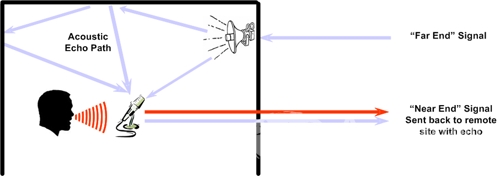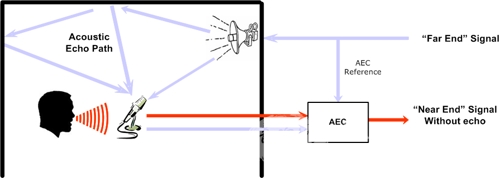The traditional telephone system hinders this natural feeling of communication. When you put your phone in your ear or bring a separate headset and microphone, the sound is completely isolated from each other. Because the phone system uses "full multiplexing technology", both parties can simultaneously send and receive sound. And when you turn your phone into hands-free mode, if the other end of the person speaks at the same time, his voice will not be successfully transmitted, otherwise it will cause an echo, and you will hear the voice of your own speech. This is the most basic form of echo cancellation, which is achieved by disabling multiplexing. This method is often used to control echo when desktop speakers are first available.
In order to achieve the most natural communication, the microphone and speaker must be kept on at all times so that the sound can be transmitted to each other at any time during the meeting, and all the things that will generate an echo path need to be cleared. The echo path refers to the journey of the sound. For example, after someone speaks, the other end of the conference receives its speech, and then the sound is picked up by the remote audio system and sent back to the original speaker. This is a great disturbance, making effective communication a luxury. The switch threshold is one way to handle this situation, but it is very unnatural. The best solution is to ensure that the meeting runs smoothly while completely blocking or greatly reducing the echo path.

Acoustic Echo Cancellation (AEC) eliminates the echo path without changing other sounds in the room. For example, someone talking to a remote person in the room against a microphone, as long as there is a microphone on the far end that will be echoed. However, if the line is equipped with an AEC, the echo can be greatly attenuated or completely eliminated. Fundamentally, AEC was developed to make teleconferencing as close as possible to face-to-face communication.
The benefits of AEC are not simply quantified, and there is no such thing as “Improve Meeting Communication: $3†in the financial statements. However, after using AEC, participants do not have to deliberately take turns to speak, making the meeting more fluid and natural. Through AEC, the intelligibility and clarity of conference communication have been significantly improved, thus reducing the psychological fatigue of previous conferences. Therefore, AEC has also improved work efficiency. The above is only part of the value-added value of AEC. The core value is to solve the problem of communication and persistence for dozens of years through a sophisticated technology.
Effective echo cancellation is not a straightforward procedure inside a DSP device. When discussing what makes BIAMP AEC so amazing, one of the main factors that has to be mentioned is that we have a team of excellent audio experts who have been cultivating sophisticated echo cancellation technology for decades. Members of the Biamp DSP team have decades of combined experience. In addition to working on new projects, the DSP team is still researching AEC to improve its functionality. There are also a number of technologies that make AEC “stunned†not clearly listed in the parameter list, which includes clean, crisp, natural sounds, and no residual echoes.
The function of almost any type of filter can be done using a DSP. “Filter†means any module that blocks or reduces a particular signal from passing. Volume control (fader) is one of the common examples because it reduces or increases the sound of the full band to achieve filtering. Permanently set a specific parameter - you have to manually change the settings to get different levels, which we call static processing. Dynamic processing means that the processing parameters are changed instantaneously without human intervention. If the specified conditions are met, the parameters will change from one quantity to another in a predetermined manner. Complex dynamic processing may use multiple layers of different response conditions and parameters. Traditional automatic mixers, threshold mixers, noise gates, compressors, and the like are used in this form of processing.
BIAMP AEC uses adaptive filtering. Adaptive processing creates an acoustic model of the room that is determined by all activated microphone signals and is subject to many factors. There are two or three people in the room, whether the door is switched or not, another person joins, moves an object or microphone, and the closer the person is to the microphone when speaking, etc., will affect the relevant pickups in the room. The device is played so that the established room model changes. The adaptive program collects all relevant data, creates a room image, and then processes it according to the current image. When the image changes, the program adjusts to the room model immediately, converges the filter parameters to the optimal parameters to achieve the ideal processing for the current room model.

All of these elements are very important for AEC processing. Although the distance between the speaker and the microphone is fixed, the sound from the speaker bounces off the wall, table top, ceiling, and other surfaces. When the number of people in the room changes, other sounds are added, or any other changes occur, whether static or dynamic changes may cause the echo path to change, and the filter fails to respond effectively to this change, AEC It will most likely make the echo pass. Our adaptive AEC is able to change the room model to reconverge at a cancellation rate of up to 100dB per second. It always changes as the room changes, establishes a real-time accurate room model, and then removes the echo path as much as possible. There is currently no standard to define adaptive processing, but in any case, this complex DSP algorithm is a major component of the BIAMP AEC .
In order to fully appreciate the value of AEC and compare it with other AEC systems, it is best for the experience person to do some actions when listening to the processing effect, such as moving tables and chairs or microphones, opening and closing the door, etc., the gap will be clear. The demonstration is also crucial for listening to such a gap. Obviously, the vast majority of people who have heard of BIAMP AEC technology and other AEC effects will eventually choose BIAMP.

For Sony:
For Xperia Z4V, For Xperia Z3V
For Google:
For Nexus 4, For Nexus 5, For Nexus 6, For Nexus 7
For MOTORALA:
For Moto Droid Turbo, For Moto Droid Turbo 2, For Moto Droid 5
For NOKIA:
For Lumia 920, For Lumia 928, For Nokia Lumia 93, For Lumia 950, For Lumia 950 XL, For Lumia 1020, For Nokia Lumia 1050, For Nokia Lumia 822, For Nokia Lumia 735
For HTC:
For HTC ONE MAX T6, For HTC Incredible 4G, For HTC ONE mini 2, For HTC Droid DNA
For LG:
For LG Nexus 4, For LG Nexus 5, For LG G Pro, For LG D1L, For LG LTE2
For Iphone:
For Iphone8/X/XR/XS Max
Compabile Models:
For Samsung:
For Galaxy S6, For Galaxy S6 Edge, For Galaxy S6 Edge+,
For Galaxy S6 Active, For Galaxy S6 Duos, For Galaxy Note Edge,
For Galaxy S7, For Galaxy S7 Edge, For Galaxy Note 5
For Galaxy S8, For Galaxy S8 Plus, For Galaxy Note 8
For Galaxy S9,For Galaxy S9 Plus
For Others:
Guangzhou HangDeng Tech Co. Ltd , https://www.hangdengtech.com